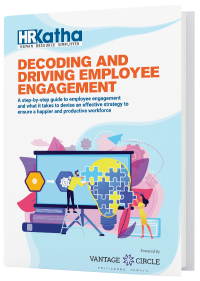6 Practices To Ensure Trust In The Workplace With Employee Engagement Initiatives

“Without trust, we don’t truly collaborate; we merely coordinate, or at best, cooperate. It is the trust that transforms a group of people into a team.”
Stephen M.R Covey
Trust in the workplace is like a currency, which is exchanged- given and received. And like all currencies, it can be converted into real-world values with employee engagement and increased productivity.
In recent years, workplace trust has eroded for several reasons. Going by statistics, according to a survey by the American Psychological Association :
24% of respondents say they don’t trust their employer.
32% believe that their employer is not always honest and truthful.
52% think that their employer is open and cooperate with them.
The Connection
The relationship between trust in the workplace and employee engagement sounds like the chicken and the egg: trust boosts engagement; engagement fuels trust. But here, it starts with trust.
It is that inevitable factor that helps employers make the most benefit from the money and energy spent on perks, programs, and benefits that get employees engaged.
Employers and employees all over the world are looking for ways to improve engagement by building better trust. But what creates it?
Here Are 6 Tactics That Builds Trust In The Workplace With Employee Engagement
1. Communicate The Need Of The Engagement Initiative
Employees want to know the motive behind the engagement activities. Sometimes even if you think you have communicated enough, you probably haven’t. They should understand what, where, when, why, and how.
Excellent communication throughout the process (right from creating the engagement design to making it happen) minimizes confusion and helps them see its benefits. In return, it boosts engagement by creating a sense of confidence and camaraderie throughout the organization.
2. Adjust The Anonymity Threshold
It holds in the case of engagement surveys in which the anonymity factor has a great significance. The anonymity threshold means the survey results will not be displayed if there is not at least a fixed number of respondents.
Suppose you fix a minimum of 5 respondents and get only four responses. In that case, you can't filter the survey result as it would be easy to connect answers to respondents.
Ensure that your survey platform has this threshold, mainly if you are a small-scale company with undersized departments. Explaining this whole process to your employees will build trust and thus encourage honest responses.
3. Provide A Candid Timeline Of What Employees Can Expect
Your employees deserve to know what’s next to their engagement at the workplace. To make this easier, make sure to provide them a timeline of the possible results.
While you expect your employees to be open, the engagement activities should invest in employee growth and development. It could include providing the necessary tools and training, or workshops to develop skills, or even offering incentives.
In simple words, if you provide them opportunities to grow and support them actively, it will increase their trust in you. But, if you aren’t timely in communicating what is earned, you can end up destroying the trust you’ve been working to build.
4. Display Your Commitment To Fair Play
Fair play is the critical element of a trusting relationship. An employee may perceive whether their engagement rewards and recognition package is appropriate in terms of:
- The amount of effort the employee invests
- The quality and impact of the employee’s performance
- The education, experience, and training the employee possesses
- The content and complexity of their current role
They will also compare fairness concerning others, like:
- Peers playing similar job role in the organization
- Supervisors and subordinates
- Employees in other organization
Any favoritism in the workplace can result in a lack of trust and kill employee motivation. Your engagement program should focus on fairness from both internal and external aspects. It is only when each of your employees feels included, you scatter the seeds of trust most evenly.
Fairness also plays a role when it comes to handling inevitable mistakes. Rewarding people for their good faith errors can help them understand what not to do and how to use their mistakes as motivators. It will build faith in the ground level.
5. Show Goodness Without Commercial Goals
Employees want to be considered beyond commercial purposes. Employers should take an interest in their employees' well-being and make efforts to improve their personal lives.
If you look at them for just business motives, it will be tough to keep them engaged in the long run. Build trust by gradually being kind and accommodating and proving that monetary goals don't just drive you.
6. Know It’s A Two-Way Street
Trust in the workplace is a two-way street. If you want your employees to trust you, you should learn to trust them as well.
“Team members who feel trusted are empowered to get work done to their best ability.”
Trusted employees feel more valued which, helps them feel more engaged. A survey by PwC says that trusted employees are 76% more engaged than those who work in a low trust workplace. Many employers think that their employees are not smart enough to handle the day-to-day challenges.
As a result, they consistently make decisions without the input of their employees. It erodes trust, which is hard to earn. At the minimum, let your employees know what you expect and acknowledge what you receive.
And finally, thank them for their contribution. In return, it will create a high level of trust in you.
The ways for building trust while boosting engagement aren’t complex, but they must be prioritized. What works for one company might not work for others. Thus, employers need to try and adopt methods that suit their business.
If you have some other points to add here, the comments section is below!

Vantage Circle is a simple AI-powered Rewards & Recognition Platform for upgrading your employee experience and engagement for better productivity.






